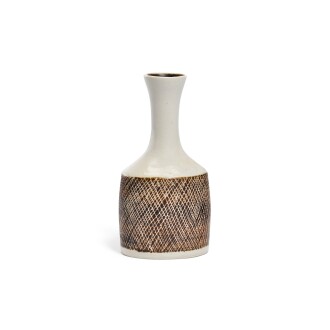A s one of Britain's most beloved ceramicists, Dame Lucie Rie believed that pottery deserved to be considered as worthy of celebration as other forms of fine art in the 20th century. Her argument is more than successful in this spectacular, round footed bowl, a highlight of Sotheby's upcoming Made in Britain sale, that proves a quintessential example of Rie’s skill and lifelong dedication to her art and her practice.
The bowl is decorated with a metallic, gold-leaf like glaze to the interior and a more traditional, earthy manganese glaze to the exterior. While the gold interior sets this particular example aside from others in her oeuvre, the present lot is made undoubtedly characteristic of Rie by its incised sgraffito line patterns radiating throughout the form.
"Rie remained loyal to the aesthetic of Viennese Modernism, and her continental preference for minimalism"
Born in Vienna in 1902 into a liberal, wealthy Jewish family, Rie at first had no intention of becoming an artist in her early education, and she instead leaned towards medicine and the sciences. It was not until she was taught under the likes of Adolf Loos and the painter Oskar Kokoschka, that she went on to enrol at the Vienna Kumstgewerbeschule where she threw clay for the first time. She went on to establish an in-depth knowledge of pottery glazes and techniques in Vienna and gained an international reputation while based there. After Austria formed a union with Nazi Germany in 1938, Rie and her husband fled to London.
Rie’s practice differed from the trends in England at the time, led by figures such as Bernard Leach and Michael Cardew. While followers of Leach embraced stoneware and earthenware, often in brown and yellow glazes, Rie remained loyal to the aesthetic of Viennese Modernism, and her continental preference for minimalism. While Leach’s pottery was made in a traditional wood-fired kiln, Rie preferred the electric kiln. With this, she experimented with a much larger scope of colours, while limiting the forms of her pieces to tableware only.
Dame Lucie Rie at Sotheby's
In 1946, Rie employed fellow ceramicist Hans Coper as an assistant in her studio. Similarly a refugee but from Germany, the two shared a studio until 1958. In describing their relationship Rie said: “I am a potter, but he is an artist”. Their influence on one another is remarkably evident, and it lead to many collaborative series of works, that proved sought after by contemporary buyers and continue to be popular with collectors today. Both in their creative partnership and independently, Rie and Coper produced works that fitted into a much more ‘contemporary’ overview.
While Rie respected Leach, and they became great friends, Rie perhaps had a different vision for her ceramics, seeing them as wholly integrated within the new, international modern world and lifestyle that she herself had experienced both in Vienna and in London. Homeware, design and architecture went hand-in-hand for Rie, who rallied for ceramics holding just as high an importance as these other categories.
Rie’s bowls hold a still grandeur to them, and often feel larger and more impressive than something the same size or fragility usually would. That is certainly true for the present lot, where the bowl seems to bloom in one’s hands, demanding full attention to its intricate detail and monumental presence. This would be in line with Rie's desired reception of her work, rarely speaking or writing about her pieces and instead leaving her porcelain, earthenware and stoneware vessels to speak for themselves.
Passing away just before the turn of the present century, Rie left her mark on ceramicists working across the world, and her legacy as a master of her craft lives on. She was recognised for her contribution to ceramics and to the wider field of design with an OBE in 1968, CBE in 1981 and DBE in 1991 and becoming a Dame. Today, her works are held in international private and public collections including the V&A in London and the Met in New York.







